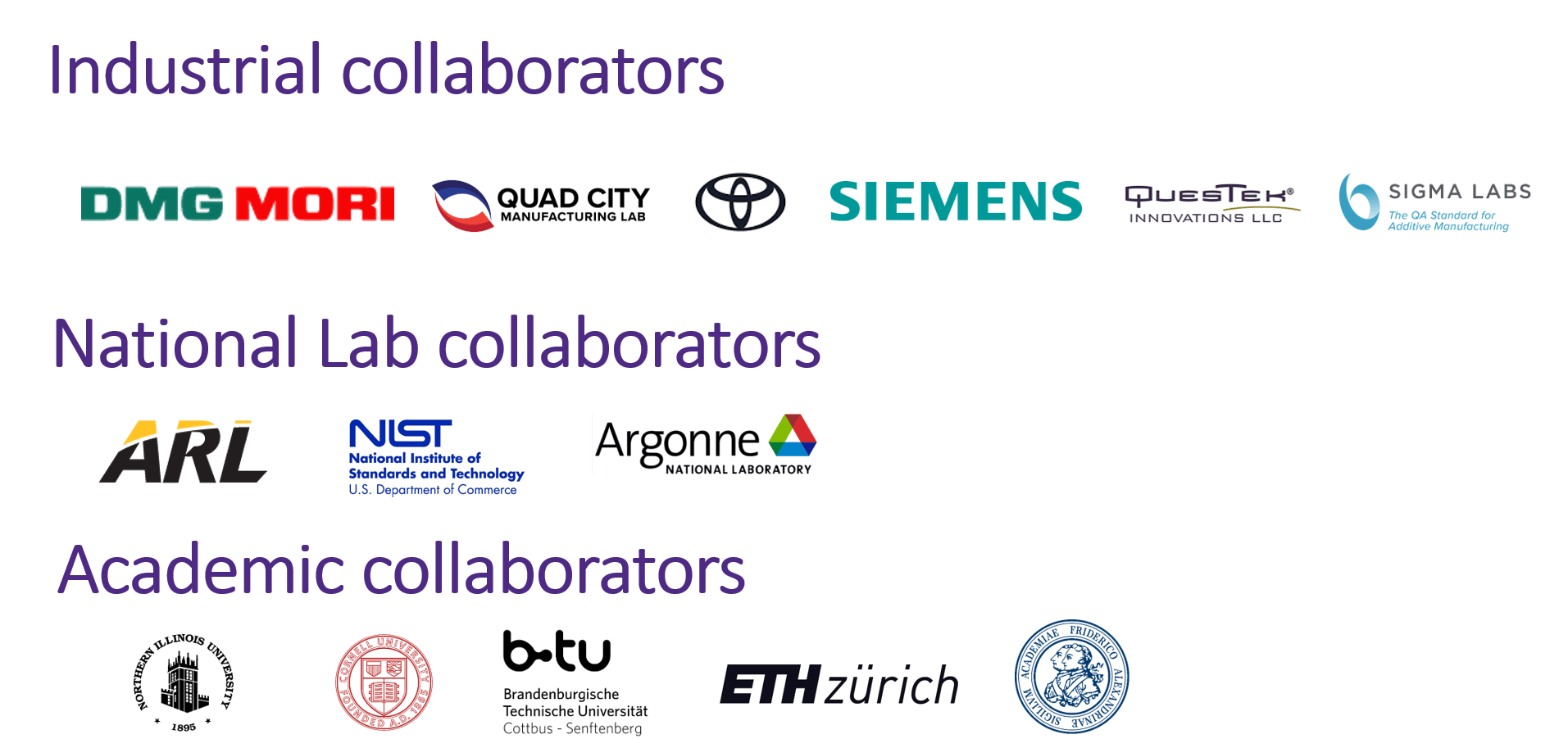We’re working on rapid certification and new process development in additive manufacturing, particularly, the Directed Energy Deposition (DED) and laser powder bed fusion (PBF), aiming to achieve desired microstructure and component geometry. Modeling efforts and in-situ monitoring at multiple scales have been conducted to understand the fundamental mechanisms and to guide process design and control.
Powder Bed Fusion (PBF) |
|---|
In-situ Monitoring of Laser/powder/melt pool Interactions
Understanding the interactions of a laser beam, flowing powders and melt pool in DED is critical for determining the effects of process parameters on the absorptivity of laser energy into the substrate, melt pool dynamics and porosity formation.
- Working with beam scientists at Argonne National Laboratory, our group is the first group to perform in-situ high-speed X-ray imaging of the DED process. We have designed unique test apparatuses aiming to reveal the underlying interactions. See our 2019 Scientific Reports paper for details.
- With a frame rate of 20 kHz, the amount of images for processing is quite labor intensive. We have explored using the template-Bayesian approach to auto-detect the existence and the shape of melt pool in those images. The original results are promising (see our 2021 CIRP paper here) and can be further improved.
- The details of our designed high-throughput in-situ mini-DED instrumentation and the corresponding methods can be found in this paper, Webster, S., Giovannini, M., Shi, Y., Martinez-Prieto, N., Fezzaa, K., Sun, T., Ehmann, K. and Cao, J. “High-throughput, In situ Imaging of Multi-layer Powder-blown Directed Energy Deposition with Angled Nozzle”, in revision.
Prediction of Spatial and Temporal Temperature Distributions
We hypothesize that the spatial and temporal distributions of temperature in AM determine the resulting material properties and geometry. Hence,
- In collaboration with our computational mechanics group, we have developed an internal thermal code called GAMMA to perform fast finite element modeling of DED and PBF. See our 2016 Computational Mechanics paper #1 and paper #2.
- We further developed a GPU version of the GAMMA code to provide 100x speed-up in computational time. See our 2019 Computational Mechanics paper #3.
- Using the thermal histories generated by GAMMA, we proposed a data-driven approach using Recurrent Neural Networks to predict the high-dimensional thermal history in DED in geometries that were not seen in the training set. The approach shows great promise in this 2018 Manufacturing Letter paper and has been further improved for more generic geometries in this 2021 Additive Manufacturing paper.
Prediction of Resulting Material Properties
Our group, in collaboration with computational mechanists and material scientists, has performed experiments and analyses using GAMMA to better understand/characterize the impact of process parameters on
- Size and distribution of porosity in DED-processed Ti-6Al-4V. See this 2017 Acta Materialia paper.
- Microhardness of DED-processed IN718 on carbon steel. See this 2019 Additive Manufacturing paper.
- Hot deformation behavior of additive manufactured Ti-6Al-4V. See this 2020 J. Materials Processing Technology paper.
- Mechanical properties of DED-processed IN718 via thermal control after secondary treatment processes. See this 2021 J. Materials Processing Technology (JMPT) paper.
For DED, we have further identified the bonding behavior of bi-metallic (17-4 PH stainless steel on copper, 2021 Manufacturing Letters paper), the wear behavior of a DED-repaired die (2019 ASME J. Manufacturing Science and Engineering paper), and the thermal metrics critical to tensile properties using mechanistic data-driven method (2021 npj Computational Materials paper) and explained those findings using observations from material microstructures and further developed an analytical model for property prediction (2021 CIRP Annals paper).
Process Monitoring and Process Control
IR cameras are commonly used for process monitoring. We have further utilized the IR image to predict and control volume change of localized areas within a laser deposited component (see 2017 J. Manufacturing Processes paper). Recently, we have collaborated with Sigma Labs and installed their system which captures the overall intensity and the intensities at two wavelengths at a frequency of 200kHz. The system has been used for process monitoring and prediction using Machine Learning (paper under review).
We are further developing numerical methods and experimental modules to enable simulation-guided process design and control to ensure a consistent or desired thermal distribution and history.
Our Research Slideshow
to be updated
Our Timeline
Our lab has participated in the following projects:

Our Collaborators
Our Journal Publications
See our publications > Additive Manufacturing for details.
Our Open-architecture AM Facilities
See our Additive Manufacturing Facilities for details.


